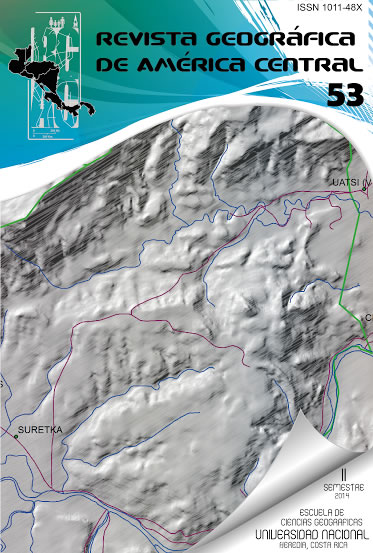ATMOSPHERIC CORRECTION METHODOLOGY FOR ASTER, RAPIDEYE, SPOT 2 AND LANDSAT 8 IMAGES WITH ENVI FLAASH MODULE SOFTWARE
DOI:
https://doi.org/10.15359/rgac.2-53.2Keywords:
radiometric correction, atmospheric correction, satellite sensors, MODTRAN4, ENVI FLAASHAbstract
The atmospheric correction process is applied to digital images in order to remove distortions induced by aerosols and intrinsic radiance introduced in a sensor and reflected in the image as a result of the interactions between the sensor and the atmosphere. By the atmospheric correction process, it’s possible to improve the overall visual quality of an image and to remove the intrusive component of the atmosphere. This paper describes the atmospheric correction process, using ENVI’s FLAASH module software, applied to data collected by four different satellite sensors: Aster, RapidEye, Spot 2 and Landsat 8. For Aster and Spot 2, atmospheric correction is shown for orthorectified GeoTIFF data that does not include the associated wavelength components, therefore the process includes the setting of these values in the image. For RapidEye and Landsat 8, the process is applied to orthorectified GeoTIFF data that includes the wavelengths components attached to the metadata for each image.
References
Abrams, M. & Hook, S. (2002). Aster user handbook. Recuperado de: http://asterweb.jpl.nasa.gov/content/03_data/04_documents/aster_user_guide_v2.pdf
Adler-Golden, S., Berk, A., Bernstein, L.S. & Richtsmeier, S. (1998). FLAASH, a MODTRAN4 atmospheric correction package for hyperspectral data retrievals and simulations. Recuperado de:
http://popo.jpl.nasa.gov/pub/docs/workshops/98_docs/2.pdf
Apollo, Mapping. (2013). SPOT 1-7. Recuperado de:
https://apollomapping.com/imagery/medium-resolution-satellite-imagery/spot
Berk, A., Anderson, G.P., Acharya, P.K., Chetwynd, J.H., Bernstein, L.S., Shettle, E.P., Matthew, M.W. & Adler-Golden, S.M. (2000). MODTRAN4 user’s manual. Recuperado de ftp://ftp.pmodwrc.ch/pub/Vorlesung%20K+S/MOD4_user_guide.pdf
BlackBridge. (2013a). Rapideye: the space segment. Recuperado de: http://blackbridge.com/rapideye/about/satellites.htm
BlackBridge. (2013b). Imágenes Satelitales Especificaciones Técnicas. Recuperado de: http://www.blackbridge.com/rapideye/upload/RE_Product_Specifications_SPA.pdf
Castillo, O.G. (2012). Aplicación espectral y topológica en el procesamiento de imágenes satelitales. (Tesis de Maestría). Universidad Nacional de Colombia, Manizales, Colombia.
Centre for Remote Imaging, Sensing & Processing (CRISP). (2001). SPOT (Satellite Pour l'Observation de la Terre), France. Recuperado de: http://www.crisp.nus.edu.sg/~research/tutorial/spot.htm
Centre National d’Etudes Spatiales (CNES). (2007). SPOT image quality perfomances. Recuperado de http://www.spot.ucsb.edu/spot-performance.pdf
Chuvieco, E. (2008). Teledetección ambiental. La observación de la tierra desde el espacio. (3. ª ed.). Barcelona: Editorial Ariel, S.A.
Edwards, A. J. (1998). Lesson 3: Radiometric correction of satellite images: when and why radiometric correction is necessary. Recuperado de http://www.ncl.ac.uk/tcmweb/bilko/module7/lesson3.pdf
EXELIS. (2014). Radiance and scale factors background. Recuperado de http://www.exelisvis.com/docs/BackgroundRadianceScaleFactors.html
Hedley, J.D. (2013). Hyperspectral Applications. Por James A. Goodman, Samuel J. Purkis y Stuart R. Phinn (Eds.). Coral Reef Remote Sensing. A guide for mapping, monitoring and management. (p. 90). USA: Springer.
International Telephone and Telegraph (ITT). (2009). Atmospheric Correction Module: QUAC and FLAASH User’s Guide. Recuperado de: http://www.exelisvis.com/portals/0/pdfs/envi/Flaash_Module.pdf
Janée, G. (2007). SPOT Mirror and Incidence Angles. Recuperado de: http://legacy.alexandria.ucsb.edu/~gjanee/spot/docs/angles.pdf
Kruse, F.A. (2004). Comparison of ATREM, ACORN, and FLAASH atmospheric corrections using low-altitude AVIRIS data of Boulder, CO. Recuperado de http://ww.w.hgimaging.com/PDF/Kruse-JPL2004_ATM_Compare.pdf
Lamolda, H. (2008). Estudio de la influencia de las correcciones a imágenes Landsat ETM+ en la obtención de propiedades de cubiertas vegetales. Madrid: Universidad Politécnica de Madrid.
López, E. (1991). Corrección atmosférica en el espectro solar. Por J. Meliá (Ed). La teledetección en el seguimiento de los fenómenos naturales. Recursos renovables: Agricultura. Valencia: Universitat de València.
Rejas, J. (2008). Tratamiento digital previo de las imágenes. Recuperado de http://api.eoi.es/api_v1_dev.php/fedora/asset/eoi:45518/componente45516.pdf
Saleska, S., Didan, K., Huete, A., Da Rocha, H. (2007). Amazon forests green-up during 2005 drought. Science. 318,612.
Samanta, A., Ganguly, S., Hashimoto, H., Devadiga, S., Vermonte, E., Knyazikhin, Y., Nemani, R.R. & Myneni R.B. (2010). Amazon forests did not green‐up during the 2005 drought. Geophysical research letters. 37: (LO5401). doi: 10.1029/2009gl042154
Sobrino, P., García-Collado, A.J., Sobrino, J.A. y Boluda, R. (1997). Corrección atmosférica de imágenes Landsat-5: Aplicación al estudio edafológico en la Comarca La Plana de Requena-Utiel. Por C. Hernández y J.E Arias (Eds). Actas del VII Congreso Nacional de Teledetección: Teledetección aplicada a la gestión de recursos naturales y medio litoral marino. Universidad de Santiago de Compostela-Asociación Española de Teledetección. Santiago de Compostela (191-194).
Spot Image. (2010). Spot satellite technical data. Recuperado de http://www2.astrium-geo.com/files/pmedia/public/r329_9_spotsatellitetechnicaldata_en_sept2010.pdf
Tagestad, J.D. (2000). Radiometric standardization of adjacent Landsat Thematic Mapper images for multi-scene mosaics. (Tesis de Maestría). Utah State University, Logan, Utah.
Tan, H. (2004). ASTER: Advanced Spaceborne Thermal Emission and Reflection Radiometer. Recuperado de http://asterweb.jpl.nasa.gov/swir-alert.asp
United States Geological Survey (USGS). (2013). Landsat Project Description. Recuperado de http://landsat7.usgs.gov/about_project_descriptions.php
United States Geological Survey (USGS). (2014). On Demand Registered Radiance at the Sensor-Orthorectified. AST14OTH. Recuperado de:
https://lpdaac.usgs.gov/products/aster_products_table/ast14oth
Weisstein, E. (2014). Full width at half maximum – A Wolfram web resource. Recuperado d: http://mathworld.wolfram.com/FullWidthatHalfMaximum.html
Downloads
How to Cite
Issue
Section
License
Proposed policy for journals offering Open Access
Authors publishing their works in the Journal acknowledge and agree to the following terms:
a) Authors retain the copyrights to their works and guarantee the Journal the right to be the first to publish their works, under the Creative Commons License Attribution-NonCommercial-ShareAlike 4.0 International, CC BY-NC-SA 4.0 International (https://creativecommons.org/licenses/by-nc-sa/4.0/deed.es), which allows others to share works upon complying with the acknowledgment of authorship and mention of the Journal as the original publisher of the work.
b) Authors are permitted to separately establish additional agreements for the non-exclusive distribution of the official edition of the work published in the Journal (for example, authors may desire to place the work in an institutional repository or incorporate it into a book that is to published elsewhere) so long they acknowledgment to recognize the Journal as the original publisher. The aforementioned additional agreements must respect the terms of the non-profit character and sharing philosophy of the original license (CC BY-NC-SA 4.0 International, https://creativecommons.org/licenses/by-nc-sa/4.0/deed.es).
c) Authors are encouraged to archive the post-print or editor/PDF version in Open Access repositories.






 REVGEO is licensed under https://creativecommons.org/licenses/by-nc-sa/4.0/deed.es
REVGEO is licensed under https://creativecommons.org/licenses/by-nc-sa/4.0/deed.es
.svg_4.png)

_(1).png)
_(1)_(1)_(1)_1.png)
(2)(1)(1)(1).png)
